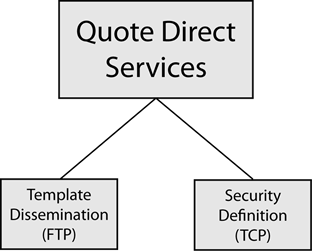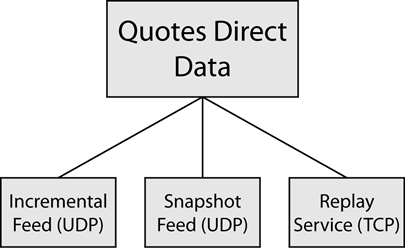
System Architecture Overview
This section contains a high level look at the production environment.

FIX clients get the templates from the FTP site, logon to the Security Definition Server, and get security definitions, which also include connection configuration.

Then FIX clients listen to the Incremental market data feeds.
Snapshot feeds and the Replay server are used to restore omitted data.
Figure 1. System Architecture
Market Data Group
Market Data Platform FIX architecture is explained in this section in terms of a market data group. A market data group is a pair of UDP channels used to produce market data messages for a set of instruments and/or a set of instrument groups.
Incremental Feed (UDP)
The Incremental Feed is used to disseminate Quotes Direct incremental market data using the bandwidth-efficient FAST encoded FIX messages. All FIX message types are sent through Incremental Feed applicable Market Data Groups (book update, statistics, quotes, trades).
Snapshot Feed (UDP)
The Snapshot Feed is used to disseminate market data snapshots for all books with any activity (i.e., bid, ask, or trade but not open interest or settlement) since the beginning of the week. Book updates (limit and implied) and statistics are sent through the applicable market data channel. A single FIX message contains the market state for a given instrument. Snapshots are replayed periodically (in cycles). Expired instruments are included on the Snapshot Feed until the end of the week (i.e., Sunday 0:00 Line Time or Chicago time).
Note: CQG strongly recommends that the Snapshot Feed be used for recovery purposes only. Once client systems have retrieved data, they should stop listening to the Snapshot Feeds.
Security Definition Server (TCP)
A Security Definition message provides information about one financial instrument. It includes:
•Connection configurations for the Incremental, Snapshot, and Replay data feeds.
Note: Connection configurations for instruments from one source (i.e., Feed ID) are the same.
•Security ID, which is needed to decipher data feeds.
The Security Definition Server (SDS) identifies the FIX clients and sends them security definitions for instruments they are enabled for. FIX clients are required to provide their username/password in order to log on to SDS.
SDS sends security definitions to qualified FIX clients that request them.
SDS does not inform about expired instruments.
New security definitions are sent to connected FIX clients as soon as they emerge.
Note: FIX clients should expect new SecurityIDs at Sunday 9:00AM CST (i.e., on the start of every service week).
Replay (TCP – Historical)
The TCP Replay component allows requesting a replay of a set of messages already published on the UDP Incremental feeds. The request specifies the messages to be replayed. The request uses the FIX Market Data Request message (35=V).
This type of request is sent through a new TCP connection established by the customer. The responses are sent by CQG through this same connection and the connection is then closed by the Replay Server once the resend is complete. All responses are FIX encoded (including the reject response). Replay is limited in the number of messages that can be requested.
Note: This is the recommended recovery method when small outages occur, like when the FIX client detects that a few messages are missing. Snapshots are better used to recover instrument states on huge outages.